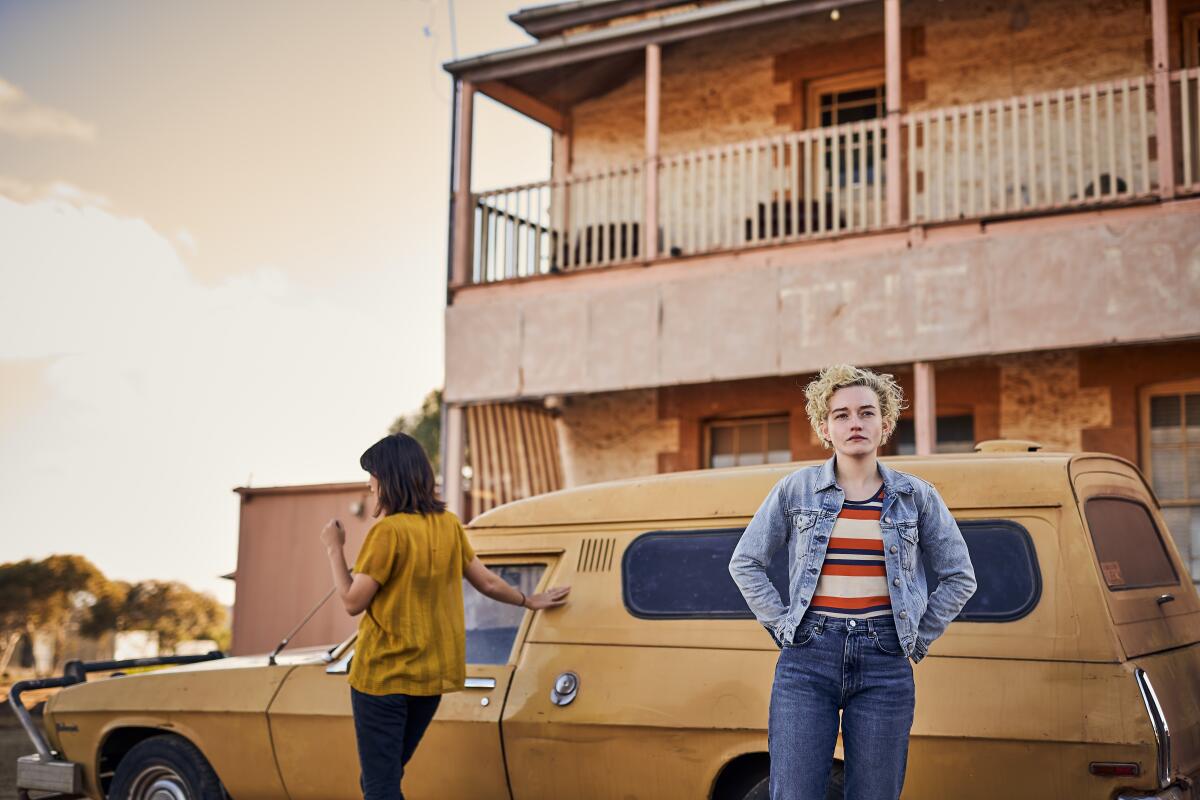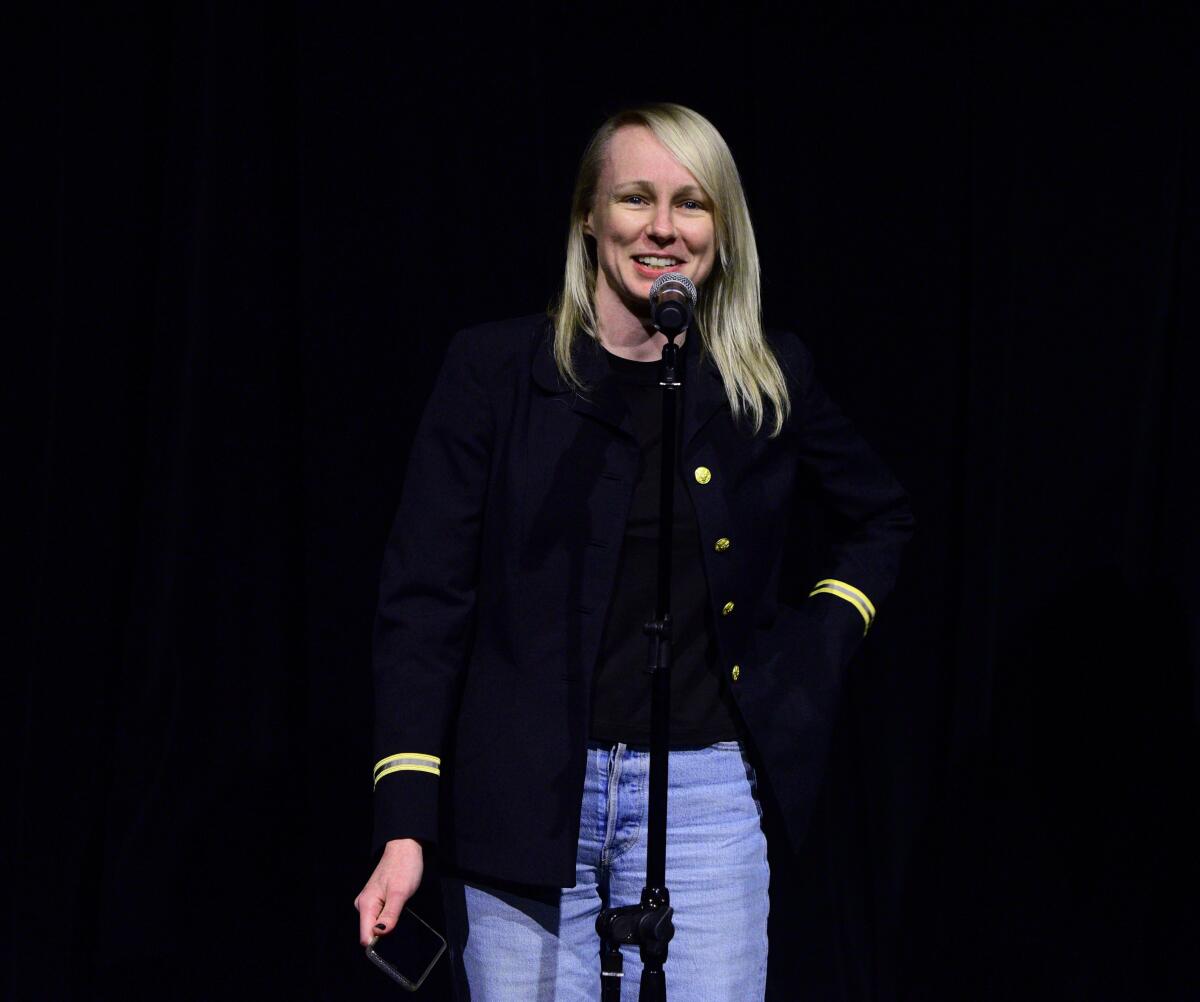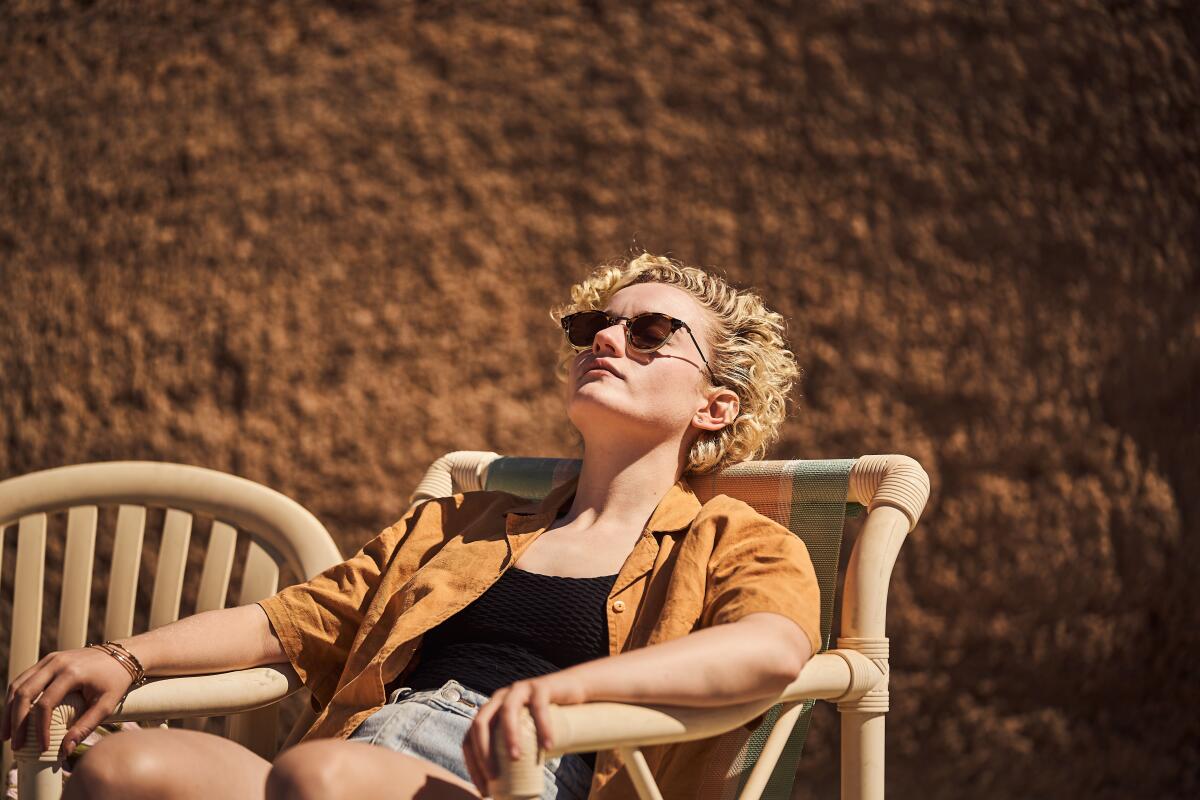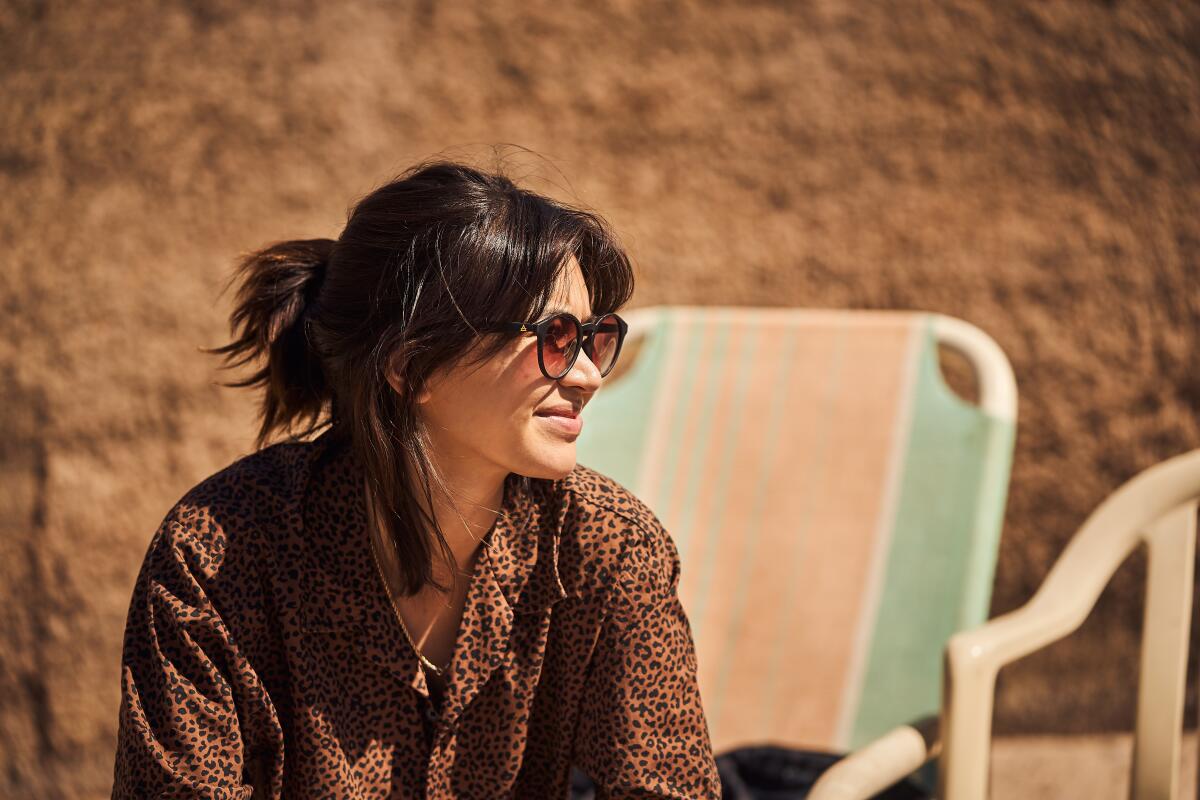How Kitty Green’s ‘The Royal Hotel’ refuses to play by the rules of horror

- Share via
Two young women with backpacks make their way down a deserted road toward a remote pub in the Australian outback, where they have been contracted to work for a few weeks. Most movie fans will think they know what’s going to happen next.
The new film “The Royal Hotel,” directed and co-written by Kitty Green, looks to subvert those expectations at every turn. Americans Hanna (Julia Garner) and Liv (Jessica Henwick) have been hiking through Australia and have run out of money. They agree to work in a bar in a rural mining town. What they find there is a group of men who may be threatening, who may be harmless but who will definitely test the limits of them both.
Green’s previous picture, 2019’s “The Assistant,” also starred Garner, playing a young office worker at a Miramax-like New York City film production company with a pervasive atmosphere of power imbalance and a constant threat of harassment. Whereas “The Assistant” was tightly contained, with an almost abstract sense of menace and pressure, “The Royal Hotel” makes it clear what the threat could be, but when or if things actually take a turn toward the sinister is another matter.
Green’s new thriller had its world premiere at the Telluride Film Festival and opens Friday in limited release. During a recent interview from New York City, she admitted that she reads not only critics’ reviews but posts on social media too, in particular the movie-centric site Letterboxd.
“It’s a bit of a divisive movie,” said Green. “I guess the conversation is a good thing. The conversation is what I wanted.”
Born in Melbourne, Green, 39, went to film school in her home country before making documentaries in Ukraine and the U.S. and shooting “The Assistant” in America. Having lived in New York for five years, she moved back to Australia to make “The Royal Hotel” and now has to decide whether she wants to return to New York, stay in Australia or move somewhere else.
Green does see “The Assistant” and “The Royal Hotel” as linked, in their psychological intensity and themes, as well as by the presence of Garner. Though perhaps not in the way some might think.
“Someone tweeted that they thought it was the same character from ‘The Assistant’ who now is in the outback, which is not true,” said Green. “It’s not that close a connection, but I kind of like that that’s out there. That made me laugh.”

You were on a film-festival jury and saw the 2016 documentary “Hotel Coolgardie,” and that became the inspiration for “The Royal Hotel.” What did that documentary spark in you?
The documentary was about two Scandinavian girls who run out money, or I think their money gets stolen, and they end up working in an outback pub. And I hadn’t seen the Australian outback through that lens: Not only just two women, but two foreign women who didn’t understand the culture, who were trying to make sense of some of the antics of the patrons of the pub. And it felt exciting to me as a jumping-off point for a screenplay.
But also, I was really struck by their strength in it. They weren’t willing to put up with some of the behavior that I think if they were Australian women, it would be a very different situation. There was something about Australian women — often we just deal with it. We go, “He’s like that, he’s all right.” We forgive that kind of behavior. And there was something nice about these Scandinavian women with their very gentle strength, being able to stand up for themselves and say no. And I felt that that was really beautiful, something I wanted to capture and play with.
I’ve heard you mention “Wake in Fright” as an obvious touchstone for “Royal Hotel.” Is there a canon of outback movies you were drawing from?
Not necessarily outback movies. It’s kind of a mix of references. I sent all these films to the actors to watch. I’m taking a tiny piece of this and a tiny piece of that. So it’s always hard to send things to people because you never know what they’ll take from them. The biggest references were “Wake in Fright,” clearly because of the pub culture there. “Straw Dogs” was a big one, just the town versus this foreign couple. There’s a lot of unease and tension in ”Straw Dogs” that we definitely referenced. There’s a bit of “Thelma and Louise” in this kind of backpacking journey.
It’s like “Wolf Creek” — there are a lot of these Australian outback horror movies that we’re actually trying to work against, we’re trying to challenge the tropes and conventions of those movies. So it’s hard for me to say “Wolf Creek” is a reference because we’re actively trying to not be “Wolf Creek.” So it’s a tricky thing to talk about reference films in that way. We also made the girls watch “Cocktail.” They had to figure out how to tend bar.

You’re never quite sure what exactly the danger is that they may be in.
I went down to Australia a few years ago, and I’d just spent some time in Brooklyn, and I was heading back to Australia and I landed on a beach somewhere in Byron Bay, beautiful beaches. And I’m thinking, “Why don’t I live here? It’s gorgeous. What am I doing in Brooklyn?” And I went out to a pub and was with some friends and some guy who I hadn’t met but was with the group asked me to ask for a Dickens Cider — for me to order a Dickens Cider. So I asked for a Dickens Cider and the bartender says, “Oh, these guys aren’t your friends.” Like, this isn’t cool. And it clicked in my head: d— inside her. So I walked back to that group, and I felt suddenly very uncomfortable being in that space, even though a few minutes before, it was all fun and jokes.
And there’s something I don’t trust about them, even though they haven’t done anything wrong. I can’t actively call them out. I can mention that it made me feel uncomfortable, but that space that you sit in often as a woman, where you’re kind of like, “Oof, I don’t know about this,” is kind of where the film exists. I’m not sure if I’m in trouble here. It seems fine, and it seems safe, but I don’t know if I trust this person. And what do you do with that kind of feeling of discomfort, and when do you stand up for yourself? When do you say no? When do you say enough is enough? What we permit or tolerate in those spaces was an interesting discussion point for me.
There’s a character who keeps trying to get one of the women in his car and it’s not really clear where he wants to take her. Was it important to you that, even during what might be the most ominous moments of the movie, you’re not totally sure what’s going on?
It was important to me that you could watch it back a second time and then realize that maybe you misunderstood it the first time. As they’re hopping in the car, one of the guys says, “Oh, we’re going down the servo,” which is like the service station, the gas station. So essentially they’re going to get cigarettes or something. There’s a way to read that as a very innocent trip to the service station, and there’s a way to read it as something a lot more sinister. And it’s Julia’s character who is always trying to decipher: Is this OK, or is this not? And in that circumstance, she’s like, “No, get my friend out of the car. I do not want her going with you.”
But all of the behavior in the movie is sitting in that kind of murky gray territory. No one’s technically crossed the line yet, which people, some of the reviewers — no, I shouldn’t go into this.
Please do.
Some of the criticism I’m reading, like Letterboxd reviews and things, is that it sort of bubbles away but never reaches boiling point. And I think people want that scene. They are looking for the rape scene or the violence. They’re looking for something that the film never gives them. And I think that’s frustrating for people because they need the release of that. There’s this idea that they can probably say, “Oh, they’re bad guys” if they actually committed that act, but if they don’t, are they just like us? It’s this sort of behavior that we partake in from time to time when we’ve had a few drinks and we’ve made the wrong joke or whatever? There’s a complicated thing with how people are sort of deciphering that kind of journey and what people want and what we’re not giving them, intentionally, but they assume we left out.
Talk a little more about that intention, the fact that the movie never goes full “Straw Dogs.”
Well, the “Straw Dogs” scene is so horrific, honestly. That “Straw Dogs” assault sequence is just — ugh. We didn’t want to make that. I don’t need to see that kind of violence against women onscreen. It’s not what I’m interested in. And so I felt like all the behavior we’re presenting in the movie is enough. The bad behavior is bad enough that we should be able to take a stand. And it’s wild to me that there are mostly men, to be honest — I’m not sure if any women think this way — men thinking that we are missing the violence, like the violence is what’s missing in this project. And that’s what they think is making it not five stars, but fours or threes, because they’re waiting for this rape scene that we’re not going to give them.
And I think that’s trying to challenge the tropes of the horror movie. As soon as you see the girls in the backpacks, you assume they’re going to be attacked or assaulted or killed because historically in cinema, two girls in the outback by themselves, that’s what happens. So to me, it was interesting to subvert that and go, “Well, what if we took these two women and we made a film about strength and about them trying to figure themselves out versus something where they’re attacked or raped or some horrifically heinous thing happens to them?” I know that we’re going to get a bit of flack for not following those conventions, but that’s intentional, clearly.

Would you mind talking about the ending? In a movie where you were trying to have so much restraint, what made you want to set it all on fire?
To me, the film is about what we tolerate, what we accept when we’re in those spaces. When is a joke just a joke? When do we say no? When do we stand up for ourselves? And to me, if we had let all that behavior go on and just let the girls head home, it would’ve been almost as if the movie is allowing or permitting this sort of behavior to happen or saying it’s OK. And I guess in the very last moment, I knew it would be provocative, I knew it would start a discussion, but I wanted to make sure we said no. The movie says no. That’s not OK. And I feel like this sort of behavior is the entry point or gateway for sexual misconduct and sexual assault. And we want to try and stop it before it ever gets there.
When they’re walking away, a woman from the bar says something to them. It’s the last line of dialogue in the movie, but I couldn’t make out what she said. I think her Australian accent was too thick for me.
“Let her rip,” is what she says. And I love that. I can’t tell if she’s laughing at them or with them, and there’s something lovely and Australian about it, which I just thought was wonderful. And I like the idea that we don’t know exactly where the movie sits, there’s something wonderful about the ambiguity of that kind of bizarre line from that bizarre woman.
And I have to say that torching the bar with a naked-lady lighter is a particularly nice touch.
We’re very proud of that. I’m not sure if we should say this, but I gave it as a crew gift to a couple of the people who worked on the movie. So there are a couple of people who have those lighters as a memento. Not sure how appropriate that is.
More to Read
Only good movies
Get the Indie Focus newsletter, Mark Olsen's weekly guide to the world of cinema.
You may occasionally receive promotional content from the Los Angeles Times.










